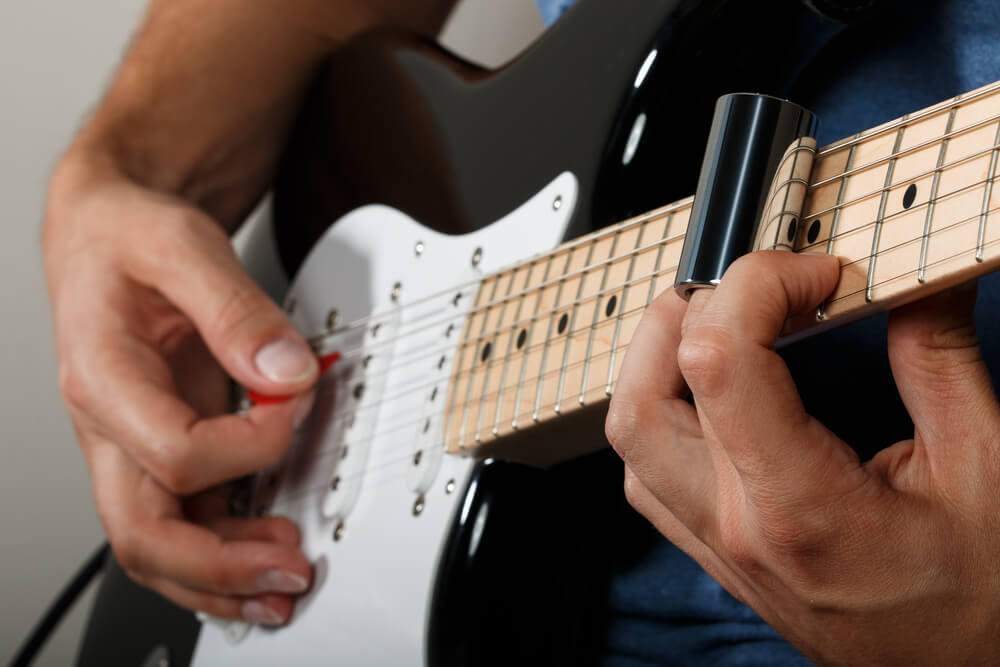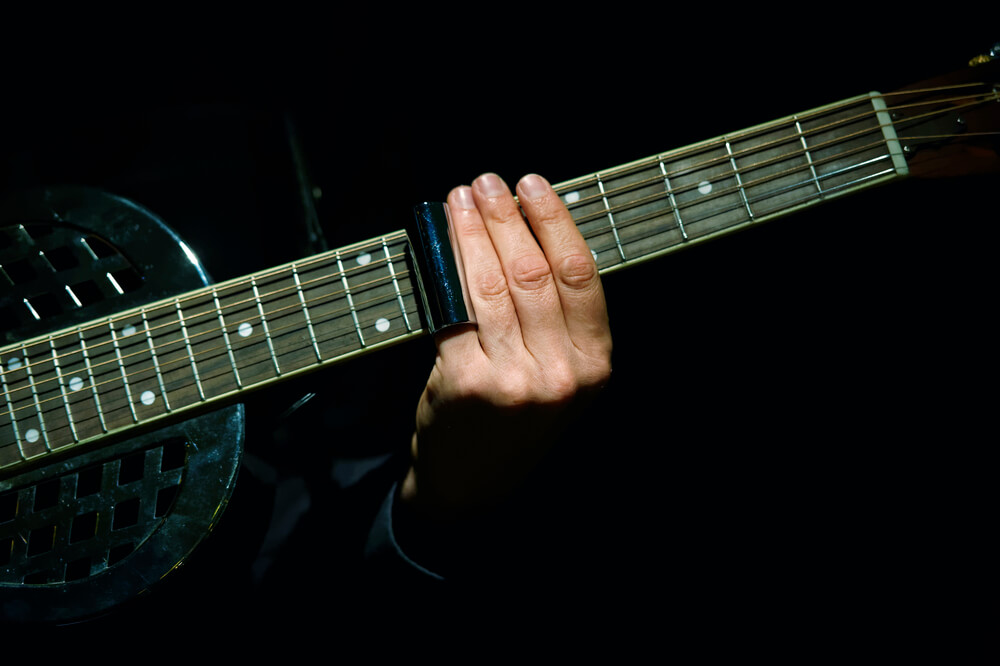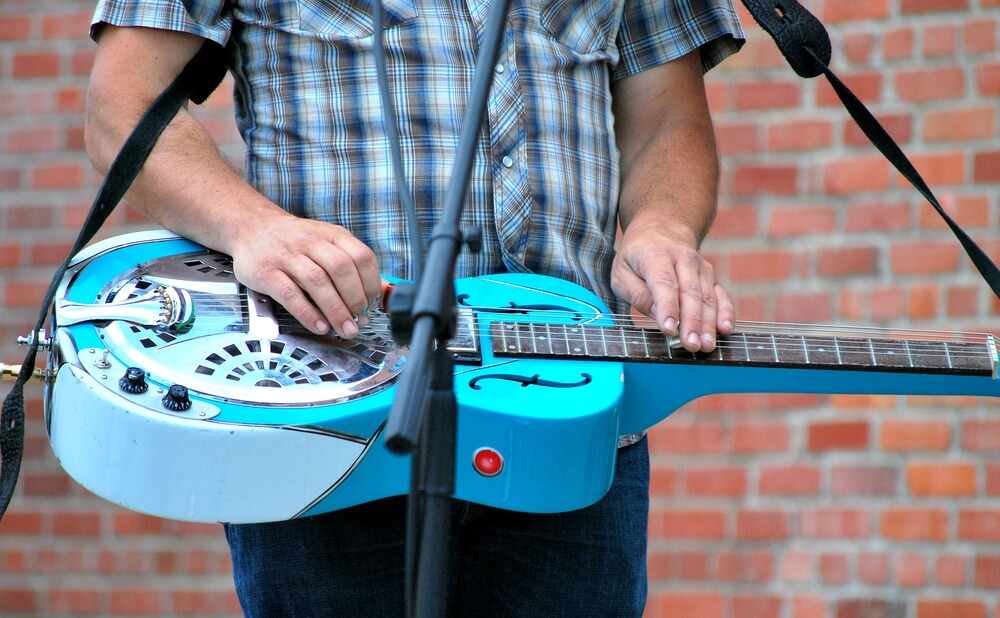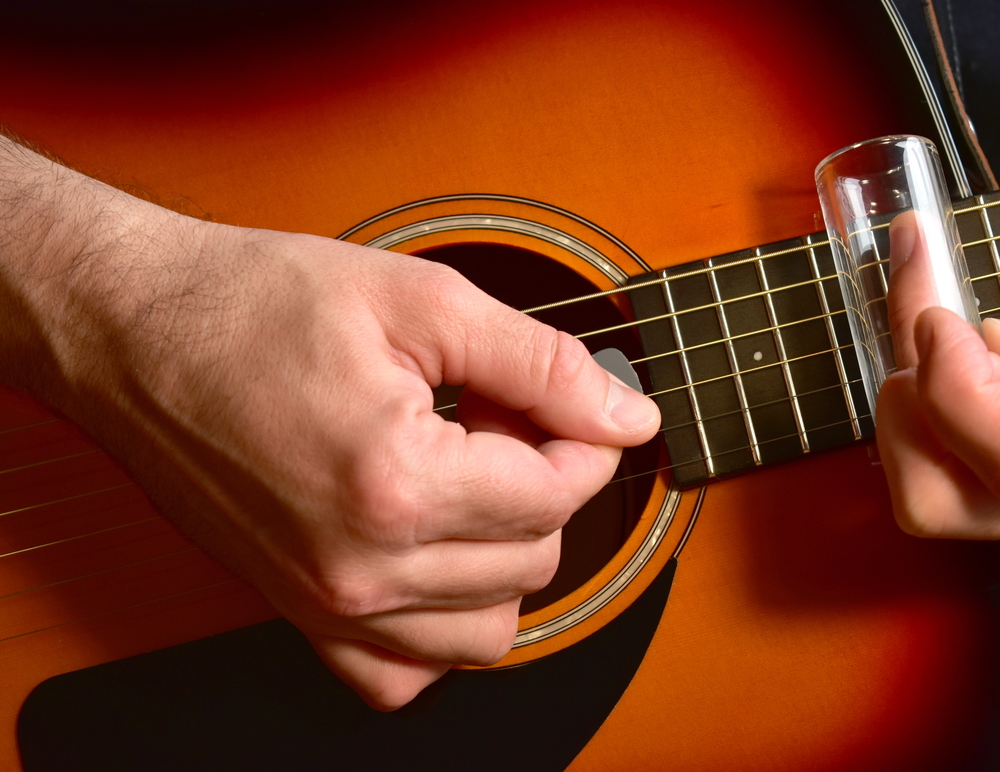Learning how to use a guitar slide can open up a whole new world of musical possibilities.
Slides have been a staple in many music genres, from blues to rock, and are an essential tool for guitarists looking to add depth and expression to their playing.
In this article, we’ll explore how to use a guitar slide, adjust your guitar for optimal slide playing, and master the basic techniques needed to make beautiful music with a slide.
Getting started with a guitar slide might seem daunting at first, but don’t worry – with some practice and patience, you’ll be playing smooth, soulful tunes in no time.
It’s essential to select a slide that feels comfortable on your finger and suits your guitar type, whether it’s acoustic or electric.
Further, it’s crucial to properly set up your guitar so that your slide can glide smoothly across the strings and you can achieve the desired sound.
Key Takeaways
- A guitar slide can enhance your playing by adding depth and expression
- Choosing the right slide and setting up your guitar properly are essential steps
- Mastering basic techniques will help you create beautiful music with a slide
How To Use A Guitar Slide
Materials
When choosing a guitar slide, the material is an essential factor to consider. Generally, guitar slides are made from glass, metal, or ceramic.
Personally, I prefer glass slides for their smooth surface, which allows for seamless sliding across the strings. They also produce a warm and soft tone.
Metal slides, such as brass, tend to have a more robust and brighter sound, making them ideal for electric guitars. Ceramic slides fall somewhere in between the two, with a unique blend of warmth and brightness.
Size and Weight
Another crucial factor to take into account is size and weight. A tight-fitting slide will help me maintain control and precision. However, it shouldn’t be too tight or uncomfortable to wear.
I try different slides to find the one that fits comfortably on my fingers while still allowing for some movement.
Lighter slides, often made of glass, are ideal for faster playing and a smoother sound. On the other hand, heavier slides, like metal ones, offer more sustain and a much bolder tone.
Depending on the style of music I want to play, I prioritize either the playability or the sustain.
Selecting the right guitar slide involves considering the material, size, and weight. While I may have personal preferences as a musician, experimenting with different materials and sizes can lead to finding the perfect slide for my style of play.
Guitar Setup for Slide Playing
Tuning
When it comes to slide guitar playing, tuning is an essential aspect. Most guitar players are accustomed to standard tuning (EADGBE), but for slide playing, there are alternative tunings that work better.
Open tunings, such as open E (EBEG#BE), open G (DGDGBD), or open D (DADF#AD), are popular because they allow you to play chords with a single slide motion.
I personally prefer open G tuning since it offers versatile chord structures and comfortable fingerings.
Action
Another crucial part of the setup process is to adjust the action, which refers to the distance between the strings and the fretboard. Slide playing requires a higher action than regular guitar playing to prevent fret buzz and achieve better sustain.
With slide guitar, you don’t press down on the strings and frets; instead, your slide should gently glide along the strings.
I suggest starting with a moderate increase in action and making adjustments until you find the optimal height for your playing style and comfort.
Some guitarists even dedicate specific guitars for slide playing, with permanently raised action.
Intonation
Lastly, slide guitar playing requires proper intonation. Intonation refers to the accuracy of pitch along the fretboard, and it plays a pivotal role in ensuring that chords and melodies sound in tune when played with a slide.
To improve intonation, you may need to adjust the saddles on your guitar’s bridge. For the best results, I recommend using an electronic tuner and checking the intonation at the 12th fret.
Remember, precise intonation is essential for a great slide guitar tone.
Addressing these three key aspects – tuning, action, and intonation – I am confident that you will optimize your guitar setup for slide playing, making it a smooth, enjoyable experience.
Basics of Using a Guitar Slide
Handling the Slide
When I start playing slide guitar, selecting the right finger to wear the slide is essential. I usually place the slide on my ring finger or pinky, as it gives me more control and lets my other fingers mute the strings.
However, some players may prefer using their middle finger. It is always a good idea to experiment to find your comfort zone and choose a technique.
The type of slide can also affect your playing. There are various materials, such as glass, metal, and ceramic, that can be used in slides. The material choice comes down to personal preference, with each one offering a unique sound and feel.
Positioning the Slide
While playing slide guitar, positioning is vital. I maintain a parallel alignment of the slide with the frets or above the fret wire on the guitar neck. It ensures a consistent and clear sound. I also apply the right amount of pressure to the strings to avoid producing buzzing or muted notes.
To enhance my guitar playing, I use my thumb to mute the lower strings and my index and middle fingers to mute the higher strings. Muting helps me prevent unwanted noise and lets the desired notes stand out.
In conclusion, practicing these techniques and exploring various slide materials can significantly improve your slide guitar playing.
Techniques for Guitar Slide Playing
Pressure Control
One critical aspect of playing with a guitar slide is to control the pressure applied to the strings. I found that finding the right amount of pressure is very important to avoid buzzing sounds and ensure a clear tone.
With too much pressure, the slide will push the strings into the frets, while too little pressure will cause the strings to rattle against the slide.
I also recommend using the pinky finger when playing with a slide, as it allows for better control over the slide and maintains the freedom to use your other fingers to fret notes or mute the strings as needed.
Slide Parallel to the Frets
Another essential aspect of guitar slide technique is keeping the slide parallel to the frets. This positioning is crucial for maintaining the proper intonation and pitch of the notes being played.
I recommend practicing this technique by placing the slide directly over the desired fret, making sure to keep it parallel and evenly spaced between each string for optimal results.
Remember that a smooth and controlled vibrato can enhance your playing style and add expressiveness to your performance.
To achieve beautiful vibrato, maintain consistent pressure and gently move the slide back and forth in an even, controlled motion.
Muting Techniques
Proper muting techniques are vital for achieving a clean, professional sound while using a guitar slide. I have found that one effective method to mute the strings is by using your fretting hand to lightly touch the strings behind the slide.
This method provides excellent control and helps prevent any unwanted vibrations, buzzing, or string noise.
Another useful muting technique is to use the palm of your picking hand to lightly rest on the strings close to the bridge.
This can provide excellent control over muting unwanted string noise while also giving you quick access to the other strings for picking or strumming purposes.
Mastering these muting techniques will drastically improve your overall slide guitar sound.
Styles of Slide Guitar
Blues
In my experience, the most well-known style of slide guitar is the blues. Its origins lie in the Delta blues music that made great use of the slide, creating a distinct, mournful sound.
Blues slide isn’t limited to a specific type of guitar but is often played on a resonator guitar or a dobro. The bottleneck slide technique, using a glass or metal tube on the finger, has become an essential part of my toolkit as a blues slide guitarist.
Some famous blues slide guitarists worth mentioning include Robert Johnson and Elmore James.
Folk
Folk music also showcases the use of guitar slides, albeit in a slightly different manner. Instead of focusing on the emotional expression like blues, folk slide guitar tends to be more delicate and melodic.
As a folk slide guitarist, I prefer to use a lap slide guitar or a Weissenborn, as these instruments allow for a more controlled and precise technique.
The slide’s emphasis on harmonics and open tunings brings out a distinctive voice within the folk genre, making it an integral part of the style.
Rock
Rock music is no stranger to the slide guitar, either. As a slide guitarist in rock, I find the style to be more aggressive and intense compared to its blues and folk counterparts.
The rock slide is often used for soloing or for creating a powerful rhythm line. Rock musicians frequently use the bottleneck technique on electric guitars to achieve a raw, gritty tone.
Some iconic rock music that features slide guitar includes songs from bands like The Allman Brothers Band, Led Zeppelin, and The Rolling Stones.
Famous Slide Guitarists and Their Styles
Duane Allman
I admire Duane Allman’s work as he is widely regarded as one of the best slide guitarists who ever lived. As a founding member of the Allman Brothers, his signature style combined influences from blues, rock, and country.
His slide techniques were flawless, using both a glass Coricidin bottle and a metal slide for different tonal values. Duane’s contributions to hits such as “Layla” showcase his evocative and melodic playing abilities.
Bonnie Raitt
Bonnie Raitt, another talented slide guitarist whom I respect, was influenced by early blues musicians like Blind Willie Johnson. She pairs a traditional glass slide with her fingerstyle technique, creating a sound that is both smooth and soulful.
Her unique style is evident in songs like “Love Me Like a Man” and “Thing Called Love.”
Robert Johnson
Robert Johnson’s influence on the world of slide guitar is undeniable. I value his mastery of open-tuning and his haunting, emotive style.
Johnson favored a metal slide, which produced a sharper sound that contributed to the dark, haunting atmosphere of his recordings.
His genius can be heard in classics such as “Cross Road Blues” and “Terraplane Blues.”
Eric Clapton
Eric Clapton’s foray into slide guitar playing was largely inspired by his admiration for Duane Allman. His style, often characterized by its restraint and melodic beauty, utilizes a glass slide for a smooth, flowing sound.
Clapton’s signature slide work can be heard in his renditions of songs like “Little Wing” and “Motherless Children.”
Jimi Hendrix
Jimi Hendrix, though not primarily known for his slide guitar, also experimented with this technique. His innovative approach blended elements of blues and psychedelia.
Hendrix famously used unconventional objects like cigarette lighters as improvised slides on occasion, demonstrating his creativity and versatility.
Songs such as “All Along the Watchtower” showcase his ability to incorporate slide guitar into his avant-garde style.
Guitar Slide for Different Types of Guitars
Acoustic Guitar
When using a guitar slide on an acoustic guitar, I find that using a medium-weight slide made of glass or brass is optimal. Both materials offer a warm tone, which complements the natural resonance of an acoustic guitar. It is important to slightly raise the action of the guitar to avoid excessive string noise and unwanted buzzing.
The key to mastering slide on an acoustic is balancing pressure and control. Lighter slides may require more pressure on the strings, while heavier slides need less pressure for smooth playing.
Electric Guitar
For electric guitars, I prefer using a slide made of glass, steel, or ceramic, each providing their unique tone. Glass slides deliver a smooth and warm sound, whereas steel and ceramic options produce brighter, more aggressive tones.
Electric guitars typically have a lower action than acoustics, so it is crucial to practice control when applying pressure with the slide. Some electric guitar players choose to use an open tuning, allowing for easier chording and harmonic options while playing with the slide.
Steel Guitar
The steel guitar is an entirely different beast, calling for a specialized guitar slide known as a “steel bar.”
It requires a unique technique compared to using a slide on an acoustic or electric guitar. I sit down when playing a steel guitar, using my left hand to hold the steel bar, applying pressure on the strings while gliding up and down the fretboard.
My right hand plucks the strings or uses finger picks to provide a clean and precise resonance. Experimenting with different steel bars, made from various materials such as steel, brass, or glass, will help find the tone that best suits your style.
Tips and Tricks for Effective Slide Playing
Gauging Your Strings
When it comes to slide guitar playing, it’s important to consider the gauge of your strings. Heavier gauge strings provide more tension on the fretboard, which can make playing with a slide easier.
I personally recommend experimenting with different gauges at your local music store to find the one that suits your playing style best. Remember that with heavier strings, it’s essential to adjust your guitar’s action to accommodate the extra tension.
Choosing the Right Fingerpick
A crucial element of slide guitar playing is fingerpicking. I find that using fingerpicks enhances my accuracy when playing chords and scales. There are various fingerpick styles available, such as plastic, metal, or even thumbpicks.
It’s crucial to find the right fit and material, so try out a variety at your music store to see which works best for you. Additionally, practicing power chords with fingerpicks will help improve your slide technique.
Practicing Scales and Songs
Finally, to become proficient in slide guitar playing, I encourage you to practice playing scales and songs. Start by focusing on mastering fundamental chords and scales on the fretboard. This solid foundation will help you transition smoothly to playing with a slide.
As you become comfortable, challenge yourself with complex rhythms and songs that incorporate various chords, such as power chords.
The key is consistent practice to develop your skills and understanding of various techniques.
Frequently Asked Questions
What is the proper technique for using a guitar slide?
To use a guitar slide properly, I ensure my slide is on the correct finger – usually the ring or pinky. I keep my fingers relaxed and parallel to the frets, lightly touching the strings with the slide.
I apply enough pressure to produce a clear sound and do not press too hard to avoid fret buzz. To practice my accuracy, I play in front of a mirror and slide between frets with precision.
How can I choose the right guitar slide for me?
To choose the right guitar slide, I first consider the material, such as glass, metal, or ceramic, depending on the tone I prefer. I also try slides of various lengths, thicknesses, and sizes for a comfortable fit.
I keep in mind that a heavier slide may provide better sustain, and a lighter one may offer more precision.
What are some easy slide guitar songs for beginners?
Some easy slide guitar songs for beginners that I recommend are “Amazing Grace,” “In My Time of Dying” by Led Zeppelin, “Little Red Rooster” by Howlin’ Wolf, and “Dust My Broom” by Elmore James.
These songs offer simple patterns and a good introduction to slide guitar techniques.
How do I play slide guitar in standard tuning?
To play slide guitar in standard tuning, I position the slide so it’s parallel to the frets and only touch the strings I want to play. I mute unwanted strings with my picking hand or other fingers on my fretting hand.
Since standard tuning is not optimized for slides, I experiment with different chords and open strings to make the most interesting sounds.
What are some essential slide guitar exercises?
Some essential slide guitar exercises I practice are single-string slides, scales using the slide, and playing simple riffs without fretting the strings. I also practiced my vibrato technique by sliding the slide back and forth over the pitch in a controlled manner.
How can I prevent squeaking while sliding on the guitar?
To prevent squeaking while sliding on the guitar, I maintain proper hand position and apply even pressure across the strings.
Additionally, I use a small amount of fingerboard lubricant on the strings, or I clean the strings regularly to reduce friction.
Finally, I practice my slides slowly and gradually increase speed to develop control and minimize unwanted noise.










